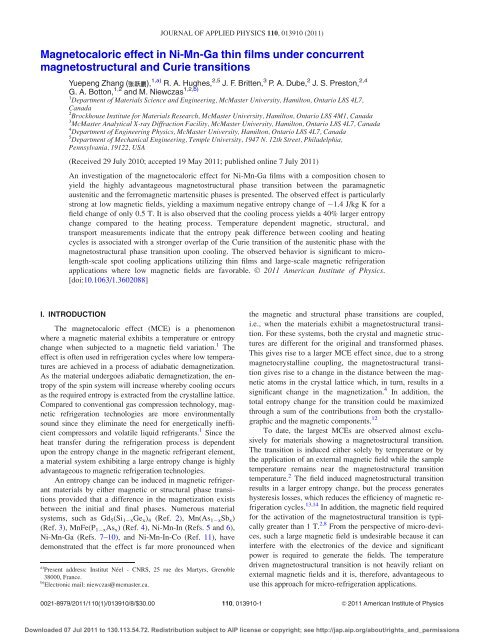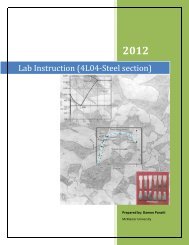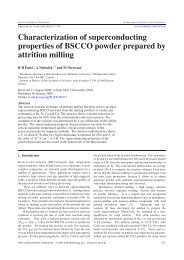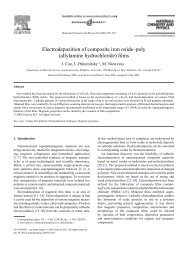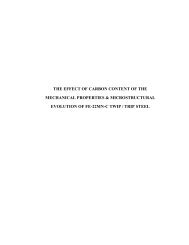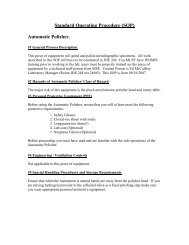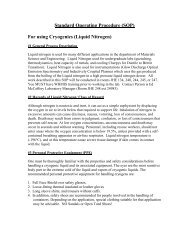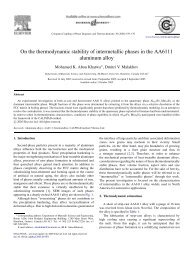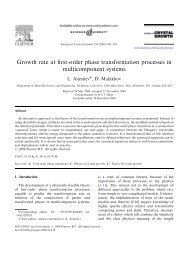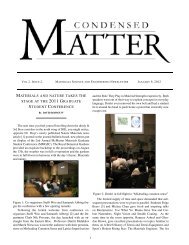Magnetocaloric effect in Ni-Mn-Ga thin films - McMaster Department ...
Magnetocaloric effect in Ni-Mn-Ga thin films - McMaster Department ...
Magnetocaloric effect in Ni-Mn-Ga thin films - McMaster Department ...
Create successful ePaper yourself
Turn your PDF publications into a flip-book with our unique Google optimized e-Paper software.
<strong>Magnetocaloric</strong> <strong>effect</strong> <strong>in</strong> <strong>Ni</strong>-<strong>Mn</strong>-<strong>Ga</strong> th<strong>in</strong> <strong>films</strong> under concurrent<br />
magnetostructural and Curie transitions<br />
Yuepeng Zhang ( ), 1,a) R. A. Hughes, 2,5 J. F. Britten, 3 P. A. Dube, 2 J. S. Preston, 2,4<br />
G. A. Botton, 1,2 and M. <strong>Ni</strong>ewczas 1,2,b)<br />
1<br />
<strong>Department</strong> of Materials Science and Eng<strong>in</strong>eer<strong>in</strong>g, <strong>McMaster</strong> University, Hamilton, Ontario L8S 4L7,<br />
Canada<br />
2<br />
Brockhouse Institute for Materials Research, <strong>McMaster</strong> University, Hamilton, Ontario L8S 4M1, Canada<br />
3<br />
<strong>McMaster</strong> Analytical X-ray Diffraction Facility, <strong>McMaster</strong> University, Hamilton, Ontario L8S 4L7, Canada<br />
4<br />
<strong>Department</strong> of Eng<strong>in</strong>eer<strong>in</strong>g Physics, <strong>McMaster</strong> University, Hamilton, Ontario L8S 4L7, Canada<br />
5<br />
<strong>Department</strong> of Mechanical Eng<strong>in</strong>eer<strong>in</strong>g, Temple University, 1947 N. 12th Street, Philadelphia,<br />
Pennsylvania, 19122, USA<br />
(Received 29 July 2010; accepted 19 May 2011; published onl<strong>in</strong>e 7 July 2011)<br />
An <strong>in</strong>vestigation of the magnetocaloric <strong>effect</strong> for <strong>Ni</strong>-<strong>Mn</strong>-<strong>Ga</strong> <strong>films</strong> with a composition chosen to<br />
yield the highly advantageous magnetostructural phase transition between the paramagnetic<br />
austenitic and the ferromagnetic martensitic phases is presented. The observed <strong>effect</strong> is particularly<br />
strong at low magnetic fields, yield<strong>in</strong>g a maximum negative entropy change of 1.4 J/kg K for a<br />
field change of only 0.5 T. It is also observed that the cool<strong>in</strong>g process yields a 40% larger entropy<br />
change compared to the heat<strong>in</strong>g process. Temperature dependent magnetic, structural, and<br />
transport measurements <strong>in</strong>dicate that the entropy peak difference between cool<strong>in</strong>g and heat<strong>in</strong>g<br />
cycles is associated with a stronger overlap of the Curie transition of the austenitic phase with the<br />
magnetostructural phase transition upon cool<strong>in</strong>g. The observed behavior is significant to microlength-scale<br />
spot cool<strong>in</strong>g applications utiliz<strong>in</strong>g th<strong>in</strong> <strong>films</strong> and large-scale magnetic refrigeration<br />
applications where low magnetic fields are favorable. VC 2011 American Institute of Physics.<br />
[doi:10.1063/1.3602088]<br />
I. INTRODUCTION<br />
The magnetocaloric <strong>effect</strong> (MCE) is a phenomenon<br />
where a magnetic material exhibits a temperature or entropy<br />
change when subjected to a magnetic field variation. 1 The<br />
<strong>effect</strong> is often used <strong>in</strong> refrigeration cycles where low temperatures<br />
are achieved <strong>in</strong> a process of adiabatic demagnetization.<br />
As the material undergoes adiabatic demagnetization, the entropy<br />
of the sp<strong>in</strong> system will <strong>in</strong>crease whereby cool<strong>in</strong>g occurs<br />
as the required entropy is extracted from the crystall<strong>in</strong>e lattice.<br />
Compared to conventional gas compression technology, magnetic<br />
refrigeration technologies are more environmentally<br />
sound s<strong>in</strong>ce they elim<strong>in</strong>ate the need for energetically <strong>in</strong>efficient<br />
compressors and volatile liquid refrigerants. 1 S<strong>in</strong>ce the<br />
heat transfer dur<strong>in</strong>g the refrigeration process is dependent<br />
upon the entropy change <strong>in</strong> the magnetic refrigerant element,<br />
a material system exhibit<strong>in</strong>g a large entropy change is highly<br />
advantageous to magnetic refrigeration technologies.<br />
An entropy change can be <strong>in</strong>duced <strong>in</strong> magnetic refrigerant<br />
materials by either magnetic or structural phase transitions<br />
provided that a difference <strong>in</strong> the magnetization exists<br />
between the <strong>in</strong>itial and f<strong>in</strong>al phases. Numerous material<br />
systems, such as Gd 5(Si 1 xGe x) 4 (Ref. 2), <strong>Mn</strong>(As 1 xSb x)<br />
(Ref. 3), <strong>Mn</strong>Fe(P1 xAsx) (Ref. 4), <strong>Ni</strong>-<strong>Mn</strong>-In (Refs. 5 and 6),<br />
<strong>Ni</strong>-<strong>Mn</strong>-<strong>Ga</strong> (Refs. 7–10), and <strong>Ni</strong>-<strong>Mn</strong>-In-Co (Ref. 11), have<br />
demonstrated that the <strong>effect</strong> is far more pronounced when<br />
a)<br />
Present address: Institut Néel - CNRS, 25 rue des Martyrs, Grenoble<br />
38000, France.<br />
b)<br />
Electronic mail: niewczas@mcmaster.ca.<br />
JOURNAL OF APPLIED PHYSICS 110, 013910 (2011)<br />
the magnetic and structural phase transitions are coupled,<br />
i.e., when the materials exhibit a magnetostructural transition.<br />
For these systems, both the crystal and magnetic structures<br />
are different for the orig<strong>in</strong>al and transformed phases.<br />
This gives rise to a larger MCE <strong>effect</strong> s<strong>in</strong>ce, due to a strong<br />
magnetocrystall<strong>in</strong>e coupl<strong>in</strong>g, the magnetostructural transition<br />
gives rise to a change <strong>in</strong> the distance between the magnetic<br />
atoms <strong>in</strong> the crystal lattice which, <strong>in</strong> turn, results <strong>in</strong> a<br />
significant change <strong>in</strong> the magnetization. 4 In addition, the<br />
total entropy change for the transition could be maximized<br />
through a sum of the contributions from both the crystallographic<br />
and the magnetic components. 12<br />
To date, the largest MCEs are observed almost exclusively<br />
for materials show<strong>in</strong>g a magnetostructural transition.<br />
The transition is <strong>in</strong>duced either solely by temperature or by<br />
the application of an external magnetic field while the sample<br />
temperature rema<strong>in</strong>s near the magnetostructural transition<br />
temperature. 2 The field <strong>in</strong>duced magnetostructural transition<br />
results <strong>in</strong> a larger entropy change, but the process generates<br />
hysteresis losses, which reduces the efficiency of magnetic refrigeration<br />
cycles. 13,14 In addition, the magnetic field required<br />
for the activation of the magnetostructural transition is typically<br />
greater than 1 T. 2,8 From the perspective of micro-devices,<br />
such a large magnetic field is undesirable because it can<br />
<strong>in</strong>terfere with the electronics of the device and significant<br />
power is required to generate the fields. The temperature<br />
driven magnetostructural transition is not heavily reliant on<br />
external magnetic fields and it is, therefore, advantageous to<br />
use this approach for micro-refrigeration applications.<br />
0021-8979/2011/110(1)/013910/8/$30.00 110, 013910-1<br />
VC 2011 American Institute of Physics<br />
Downloaded 07 Jul 2011 to 130.113.54.72. Redistribution subject to AIP license or copyright; see http://jap.aip.org/about/rights_and_permissions
013910-2 Zhang et al. J. Appl. Phys. 110, 013910 (2011)<br />
The <strong>Ni</strong>-<strong>Mn</strong>-<strong>Ga</strong> system exhibits a temperature driven<br />
magnetostructural transition. Both the Curie and martensitic<br />
transition temperatures can be tuned over a wide temperature<br />
range through the adjustment of the valence electron to atom<br />
ratio (e/a) associated with a particular alloy composition. 15,16<br />
For small e/a ratios (i.e., e/a < 7.7) the martensitic transition<br />
occurs <strong>in</strong> a temperature range far below the Curie temperature,<br />
while the reverse tendency occurs for larger ratios (i.e.,<br />
e/a > 7.7) (Ref. 17). The <strong>in</strong>termediate range (i.e., e/a 7.7),<br />
where the two transitions overlap, 17,18 is therefore of the<br />
greatest <strong>in</strong>terest to MCE applications. Various reports on the<br />
MCE <strong>in</strong> bulk <strong>Ni</strong>-<strong>Mn</strong>-<strong>Ga</strong> samples have recently been presented,<br />
8,9,19,20 however, the application of this <strong>effect</strong> to<br />
micro-scale applications us<strong>in</strong>g th<strong>in</strong> <strong>films</strong> has received little<br />
attention. 21 Here, we present a study of the magnetocaloric<br />
<strong>effect</strong> <strong>in</strong> <strong>Ni</strong>-<strong>Mn</strong>-<strong>Ga</strong> <strong>films</strong> with an e/a ratio of 7.73. The <strong>films</strong><br />
exhibit a Curie transition of the austenitic phase which is<br />
co<strong>in</strong>cident with the magnetostructural phase transition<br />
between the paramagnetic austenitic and ferromagnetic martensitic<br />
phases. The overlap, however, is stronger upon cool<strong>in</strong>g<br />
than heat<strong>in</strong>g. The cool<strong>in</strong>g transition results <strong>in</strong> an entropy<br />
change which is 40% larger than that obta<strong>in</strong>ed for gadol<strong>in</strong>ium<br />
<strong>films</strong>. 22 These f<strong>in</strong>d<strong>in</strong>gs <strong>in</strong>dicate that <strong>Ni</strong>-<strong>Mn</strong>-<strong>Ga</strong> <strong>films</strong> are<br />
excellent candidates for micro-length-scale magnetic refrigeration<br />
applications such as spot cool<strong>in</strong>g <strong>in</strong> microelectromechanical<br />
systems (MEMS) 23 and micro-energy storage<br />
devices. 24<br />
II. EXPERIMENTAL<br />
In an earlier report 25 we detailed a procedure for the<br />
deposition of (101)-oriented <strong>Ni</strong>-<strong>Mn</strong>-<strong>Ga</strong> <strong>films</strong> on (100) YSZ<br />
(Y 2O 3 stabilized ZrO 2 with 8 Mole% Y 2O 3) substrates <strong>in</strong> a<br />
previously unexplored high deposition temperature regime<br />
us<strong>in</strong>g the pulsed laser deposition technique. For this method,<br />
high growth temperatures became accessible through the use<br />
of target materials enriched <strong>in</strong> both manganese and gallium,<br />
where the enrichment compensated for the high vapor pressures<br />
of these elements. The <strong>films</strong> produced by this procedure<br />
showed improved crystall<strong>in</strong>ity with micrometer-sized<br />
gra<strong>in</strong>s and the desired highly-tw<strong>in</strong>ned microstructure for the<br />
martensitic phase. These properties gave rise to both a welldef<strong>in</strong>ed<br />
reversible martensitic transformation above room<br />
temperature and a reversible magnetically <strong>in</strong>duced tw<strong>in</strong> variant<br />
reorientation <strong>effect</strong>. 25,26 The thickness of the <strong>films</strong> is 250<br />
nm. The composition of the <strong>films</strong>, as determ<strong>in</strong>ed by x-ray<br />
energy dispersive spectroscopy taken with the JEOL 2010<br />
FEG STEM, is <strong>Ni</strong>51<strong>Mn</strong>29<strong>Ga</strong>20ðat:%Þ. This composition corresponds<br />
to an electron to atom ratio (e/a) of 7.73; a value <strong>in</strong><br />
the range where the martensitic and magnetic phase transitions<br />
overlap. 17,18 The three-dimensional x-ray diffraction<br />
(XRD3) measurements carried out at both 380 K and room<br />
temperature reveal an austenitic phase with a cubic crystal<br />
structure hav<strong>in</strong>g lattice parameters of a ¼ b ¼ c ¼ 5.846(3) A ˚<br />
and a martensitic phase hav<strong>in</strong>g an orthorhombic structure<br />
with a ¼ 6.112(4) A ˚ , b¼ 5.885(3) A ˚ , and c ¼ 5.527(2) A ˚<br />
(Ref. 26).<br />
The phase transformations and magnetic properties of<br />
<strong>Ni</strong>51<strong>Mn</strong>29<strong>Ga</strong>20 <strong>films</strong> were studied us<strong>in</strong>g different techniques.<br />
Temperature dependent XRD3 measurements were used to<br />
monitor the crystallographic phase transformation. The<br />
measurements were performed with a Rigaku RU-200 rotat<strong>in</strong>g<br />
anode Cu Ka x-ray generator, on a Bruker 3-circle D8<br />
goniometer with a parallel-focus<strong>in</strong>g mirror optic, and a<br />
Smart 6000 CCD detector. Electrical resistivity measurements<br />
were carried out us<strong>in</strong>g an <strong>in</strong>-house developed four-po<strong>in</strong>t Van<br />
der Pauw resistivity apparatus, capable of operat<strong>in</strong>g between<br />
4 and 410 K. The isothermal and temperature dependent magnetization<br />
was obta<strong>in</strong>ed with a Quantum Design magnetic<br />
property measurement system associated with the superconduct<strong>in</strong>g<br />
quantum <strong>in</strong>terference device. Other experimental<br />
details are available elsewhere. 25,26<br />
III. RESULTS<br />
A. Phase transformations<br />
The temperature dependence of the structural phase<br />
transition for the <strong>Ni</strong>51<strong>Mn</strong>29<strong>Ga</strong>20 <strong>films</strong> was directly observed<br />
us<strong>in</strong>g a three-dimensional XRD technique. The analysis of<br />
the <strong>in</strong>tensities of the (400) and (004) martensite and (400)<br />
austenite reflections dur<strong>in</strong>g the heat<strong>in</strong>g and cool<strong>in</strong>g sequences<br />
allows for the characterization of the structural phase<br />
transformation based on the relative <strong>in</strong>tensities of these diffraction<br />
peaks. Figure 1 shows the progression of the peak<br />
<strong>in</strong>tensities as the film is heated from 233 to 371 K and then<br />
cooled back down to 233 K. A response dom<strong>in</strong>ated by the<br />
cubic austenitic and orthorhombic martensitic phases,<br />
respectively, is observed at the high and low temperature<br />
extremes of the sequence. Between 299 and 371 K there<br />
exists a mixed response of vary<strong>in</strong>g degree which characterizes<br />
the phase coexistence, which is a feature typical for a<br />
first-order phase transition. The back and forth<br />
FIG. 1. (Color onl<strong>in</strong>e) Three-dimensional x-ray diffraction data show<strong>in</strong>g the<br />
structural phase transition for a <strong>Ni</strong>51<strong>Mn</strong>29<strong>Ga</strong>20 film as the temperature is<br />
cycled back and forth through the martensite-austenite phase transition. The<br />
data at 371 K shows only a s<strong>in</strong>gle (400) peak for the cubic austenitic phase<br />
while the 233 K data shows the (400)/(004) peak splitt<strong>in</strong>g expected for the<br />
orthorhombic martensitic phase. A first-order martensitic phase transformation<br />
occurs between 299 and 371 K where one phase gradually transforms<br />
<strong>in</strong>to the other. In this temperature regime, all three peaks are visible due to<br />
the austenite-martensite phase coexistence. Note that the phase transition is<br />
completely reversible and exhibits a hysteresis. Also noteworthy is the<br />
existence of an extremely weak peak between the two martensite peaks at<br />
233 K, which is a feature consistent with residual levels of the austenitic<br />
phase.<br />
Downloaded 07 Jul 2011 to 130.113.54.72. Redistribution subject to AIP license or copyright; see http://jap.aip.org/about/rights_and_permissions
013910-3 Zhang et al. J. Appl. Phys. 110, 013910 (2011)<br />
FIG. 2. (Color onl<strong>in</strong>e) Temperature dependence of the volume fractions for<br />
the martensitic (circles) and austenitic (triangles) phases dur<strong>in</strong>g the heat<strong>in</strong>g<br />
(top) and cool<strong>in</strong>g (bottom) processes. The dashed l<strong>in</strong>es denote the temperatures<br />
correspond<strong>in</strong>g to Theat 50 ¼ 358 K and Tcool 50 ¼ 355 K (i.e., where the volume<br />
fractions for the two phases are equal). The fact that these values are<br />
offset by about 3 K is a clear <strong>in</strong>dication of the temperature hysteresis <strong>in</strong> the<br />
phase transformation. The l<strong>in</strong>e connect<strong>in</strong>g the data po<strong>in</strong>ts is a guide for the<br />
eye.<br />
transformations between the martensitic and austenitic<br />
phases, and the associated hysteresis, are quite apparent. The<br />
fact that even at the lowest temperature (i.e., 233 K) residual<br />
amounts of the austenitic phase exist is noteworthy. This observation<br />
is consistent with the room-temperature transmission<br />
electron microscopy images which show a 2–3 nm thick<br />
austenite layer at the film-substrate <strong>in</strong>terface. 26 The complete<br />
reversibility of the martensitic transformation is also evident<br />
from the data.<br />
The volume fractions for the austenitic and martensitic<br />
phases over the entire heat<strong>in</strong>g-cool<strong>in</strong>g cycle were extracted<br />
form the data <strong>in</strong> Fig. 1. The values were determ<strong>in</strong>ed by compar<strong>in</strong>g<br />
the <strong>in</strong>tegrated peak <strong>in</strong>tensities <strong>in</strong> the two-phase<br />
regions to those obta<strong>in</strong>ed at the high and low temperatures<br />
where a s<strong>in</strong>gle phase dom<strong>in</strong>ates (i.e., 371 and 299 K). This<br />
methodology yields temperature dependent volume fractions<br />
for the austenitic (fA) and martensitic (fM) phases which are<br />
given by,<br />
fAðTÞ ¼ IAðTÞ<br />
IAð371 KÞ ; fMðTÞ ¼ IMðTÞ<br />
; (1)<br />
IMð299 KÞ<br />
where IA and IM are the <strong>in</strong>tegrated <strong>in</strong>tensities of the (400)<br />
pole from the austenitic phase and the (040) pole from the<br />
martensitic phase, respectively. Figure 2 shows the temperature<br />
dependence of the austenite and martensite volume fractions<br />
as obta<strong>in</strong>ed from the XRD measurements for both the<br />
heat<strong>in</strong>g and cool<strong>in</strong>g sequences. The data reveal a hysteresis<br />
<strong>in</strong> the first-order phase transformation and allows for the<br />
extraction of the values Tcool 50 ¼ 355 K and Theat 50 ¼ 358 K,<br />
which def<strong>in</strong>e the temperatures where the film is comprised of<br />
equal amounts of the austenitic and martensitic phases dur<strong>in</strong>g<br />
the cool<strong>in</strong>g and heat<strong>in</strong>g sequences, respectively.<br />
The temperature dependence of the resistivity for the<br />
<strong>Ni</strong>51<strong>Mn</strong>29<strong>Ga</strong>20 <strong>films</strong> was measured for temperatures between<br />
7 and 400 K. The results shown <strong>in</strong> Fig. 3 reveal a welldef<strong>in</strong>ed<br />
hysteretic feature extend<strong>in</strong>g from 307 to 370 K,<br />
which is consistent with the martensitic phase transformation<br />
FIG. 3. Temperature dependent dc resistivity measured us<strong>in</strong>g the Van der<br />
Pauw technique. The characteristics show a reversible martensitic transformation<br />
<strong>in</strong> the temperature range of 307 to 370 K. All values were normalized<br />
to the resistivity (q 0) of the <strong>films</strong> at 7 K.<br />
observed with three-dimensional XRD. Us<strong>in</strong>g the deviation<br />
from l<strong>in</strong>earity <strong>in</strong> the slope of the resistivity-temperature characteristics<br />
as a criterion for the beg<strong>in</strong>n<strong>in</strong>g and end<strong>in</strong>g of the<br />
phase transformation, the austenite to martensite phase transformation<br />
start (Ms) and f<strong>in</strong>ish (Mf) temperatures, and the<br />
martensite to austenite transformation start (As) andf<strong>in</strong>ish<br />
(Af) temperatures, were determ<strong>in</strong>ed to be Ms ¼ 361 K,<br />
Mf ¼ 307 K, As ¼ 312 K, and Af ¼ 370 K. With no other<br />
resistivity anomaly present <strong>in</strong> the data down to 7 K it is likely<br />
that the <strong>films</strong> have no <strong>in</strong>ter-martensitic transformations.<br />
Temperature dependent dc magnetization measurements,<br />
carried out <strong>in</strong> a magnetic field of l 0H ¼ 0:005 T<br />
between 2 and 400 K, were used to probe the ferromagnetic<br />
phase transition. The results are shown <strong>in</strong> Fig. 4. The rapid<br />
<strong>in</strong>crease of magnetization <strong>in</strong> the temperature range between<br />
352 and 360 K reveals the existence of a ferromagnetic transition.<br />
It is noteworthy that the M(T) curve shows a hysteresis<br />
between the cool<strong>in</strong>g and heat<strong>in</strong>g sequences along with a<br />
FIG. 4. (Color onl<strong>in</strong>e) Temperature dependent dc magnetization for a<br />
<strong>Ni</strong>51<strong>Mn</strong>29<strong>Ga</strong>20 film <strong>in</strong> an external magnetic field of 0.005 T, for both the<br />
cool<strong>in</strong>g (backward arrow) and heat<strong>in</strong>g (forward arrow) sequences. The magnetization<br />
curves show a peak near 352 K and a hysteresis between the cool<strong>in</strong>g<br />
and heat<strong>in</strong>g sequences due to the concurrent magnetostructural and<br />
Curie transitions. The <strong>in</strong>set shows an expanded view for the temperature<br />
range of 335–375 K, which reveals a cross-over <strong>in</strong> the magnetization curves<br />
at 356 K.<br />
Downloaded 07 Jul 2011 to 130.113.54.72. Redistribution subject to AIP license or copyright; see http://jap.aip.org/about/rights_and_permissions
013910-4 Zhang et al. J. Appl. Phys. 110, 013910 (2011)<br />
peak. This peak, which is centered around 352 K, has a lower<br />
maximum value <strong>in</strong> the heat<strong>in</strong>g sequence than it does <strong>in</strong> the<br />
cool<strong>in</strong>g sequence. There does exist, however, a cross-over<br />
po<strong>in</strong>t at 356 K, demarcat<strong>in</strong>g a 7 K temperature <strong>in</strong>terval<br />
where the observed magnetization dur<strong>in</strong>g the heat<strong>in</strong>g<br />
sequence is somewhat higher. Of the utmost importance is<br />
the fact that the magnetic transition overlaps with the structural<br />
transition observed <strong>in</strong> the three-dimensional XRD and<br />
resistivity measurements (Figs. 1 and 3). This scenario, while<br />
only rarely reported for <strong>Ni</strong>-<strong>Mn</strong>-<strong>Ga</strong> <strong>films</strong>, has been attributed<br />
to the composition of the alloy 27 and is responsible for the<br />
observed hysteresis and cross-over <strong>in</strong> the temperature <strong>in</strong>terval<br />
of the magnetic transition.<br />
While the overlap <strong>in</strong> the structural and magnetic phase<br />
transitions complicates the magnetization data considerably,<br />
it is still possible to extract the Curie temperature,Tc, through<br />
suitable process<strong>in</strong>g of the dataset. This temperature is typically<br />
obta<strong>in</strong>ed from the <strong>in</strong>flection po<strong>in</strong>t <strong>in</strong> the magnetization’s<br />
temperature dependence, but such a procedure is<br />
<strong>in</strong><strong>effect</strong>ive here due to the complex shape of the magnetization<br />
curve (Fig. 4). An alternative method relies on an Arrott<br />
plot 28 which determ<strong>in</strong>es the Curie temperature from the<br />
measured magnetization isotherms. The method requires that<br />
the magnetization is plotted <strong>in</strong> the form of M2 versus H=M,<br />
where a l<strong>in</strong>ear extrapolation of the high field data to the zero<br />
magnetic field yields the square of the spontaneous magnetization,<br />
M2 0 . In the ferromagnetic region (i.e., T < Tc), M2 0 is<br />
positive 29 while <strong>in</strong> the paramagnetic region (i.e., Tc) itis<br />
negative (i.e., where the M2 versus H=M curve <strong>in</strong>tercepts<br />
the H/M-axis). 29 At T ¼ Tc, the spontaneous magnetization<br />
is zero and, thus, the M2 versus H=M curve passes through<br />
the orig<strong>in</strong>. The low field data is excluded from the extrapolation<br />
because it represents an averaged response over differently<br />
oriented magnetic doma<strong>in</strong>s. 29<br />
In this study, the magnetization isotherms used to generate<br />
the Arrott plots were measured <strong>in</strong> a cool<strong>in</strong>g sequence<br />
(Fig. 5) s<strong>in</strong>ce the onset of ferromagnetism is more accurately<br />
determ<strong>in</strong>ed than its disappearance. 28 It is also noted that the<br />
Curie temperature of the martensitic phase, TM c , significantly<br />
differs from that of the austenitic phase due to the different<br />
crystal structures of the two phases. 30,31 This is not surpris<strong>in</strong>g<br />
s<strong>in</strong>ce the <strong>Mn</strong>-<strong>Mn</strong> <strong>in</strong>teratomic distances with<strong>in</strong> the unit<br />
FIG. 5. The isothermal magnetization curves for a <strong>Ni</strong>51<strong>Mn</strong>29<strong>Ga</strong>20 film<br />
measured at different temperatures, which extend through the magnetostructural<br />
phase transformation.<br />
cell are different for the austenitic and martensitic lattices,<br />
and it is these distances which, to a large degree, determ<strong>in</strong>e<br />
the sp<strong>in</strong> exchange <strong>in</strong>teractions responsible for the magnetic<br />
order<strong>in</strong>g. 30 The Tc temperature determ<strong>in</strong>ed here through the<br />
Arrott plots is the Curie temperature of the austenitic phase,<br />
TA c , s<strong>in</strong>ce the magnetization isotherms used are measured at<br />
the temperatures where austenite is the predom<strong>in</strong>ant phase<br />
(i.e., those measured at temperatures above Tcool 50 ¼ 355 K).<br />
In fact, for the <strong>films</strong> studied here, the Curie temperature of<br />
the martensitic phase, TM c , is a virtual temperature s<strong>in</strong>ce it is<br />
well above the temperatures where the martensitic phase persists<br />
(i.e., TM c > Ms). This is apparent from the temperature<br />
dependent dc magnetization (Fig. 4) which does not show<br />
any anomalies below the martensitic transformation f<strong>in</strong>ish<br />
temperature of 307 K. Such a virtual transition temperature<br />
can still be estimated through the orthodox Landau theory, 30<br />
but this aspect is beyond the scope of this paper. The important<br />
po<strong>in</strong>t be<strong>in</strong>g made here is that the two phases spontaneously<br />
magnetize at different temperatures and it is the Curie<br />
transition of the austenitic phase that overlaps with the martensitic<br />
transformation. It should also be noted that at the<br />
martensitic transformation start temperature, Ms, the two<br />
structural phases have a different magnetic characteristic<br />
where the austenitic phase is paramagnetic (i.e., the magnetization<br />
is zero for temperatures above Ms ¼ 361 K; see Fig. 4)<br />
while the martensitic phase is ferromagnetic (TM c > Ms).<br />
Therefore, the transition between the two structural phases<br />
is, <strong>in</strong> fact, a magnetostructural phase transition. To determ<strong>in</strong>e<br />
the Curie temperature of the austenitic phase, TA c , the<br />
M2 versus H=M curves were measured <strong>in</strong> the temperature<br />
range of 356–362 K, where the austenitic phase predom<strong>in</strong>ates<br />
(Tcool 50 ¼ 355 K), as is shown <strong>in</strong> Fig. 6. At 360 and<br />
362 K, the l<strong>in</strong>ear extrapolation of the high field data<br />
ðl0H > 0:4 TÞ<strong>in</strong>tercepts the H/M-axis while at 356 and 358<br />
K it <strong>in</strong>tercepts the M2 axis. This <strong>in</strong>dicates that the TA c temperature<br />
is around 359 K. This value is consistent with that<br />
observed for bulk <strong>Ni</strong>-<strong>Mn</strong>-<strong>Ga</strong> samples of similar composition.<br />
32 For the purpose of comparison, the 352 and 354 K<br />
FIG. 6. (Color onl<strong>in</strong>e) M 2 vs H/M plots for a <strong>Ni</strong>51<strong>Mn</strong>29<strong>Ga</strong>20 film derived<br />
from the isothermal magnetization data for temperatures between 352 and<br />
362 K. A l<strong>in</strong>ear extrapolation of the high field data (l0H > 0:4 T) for the<br />
356–362 K curves was used to estimate the Curie temperature of the austenitic<br />
phase. The fact that M2 0 is positive at 358 K but negative at 360 K <strong>in</strong>dicates<br />
the onset of the ferromagnetic transition of the austenitic phase near 359 K.<br />
Downloaded 07 Jul 2011 to 130.113.54.72. Redistribution subject to AIP license or copyright; see http://jap.aip.org/about/rights_and_permissions
013910-5 Zhang et al. J. Appl. Phys. 110, 013910 (2011)<br />
isotherms, where the response is dom<strong>in</strong>ated by the martensitic<br />
phase, are also presented <strong>in</strong> Fig. 6. The fact that these<br />
two curves exhibit very different curvatures at high fields as<br />
compared to the 356–362 K data is consistent with the argument<br />
that the martensitic and austenitic phase each has different<br />
magnetic response and Curie temperature.<br />
It should be noted that the Arrott plot is based on the<br />
equation of state: 33 ðH=MÞ 1=c ¼ðT TcÞ=T1 þðM=M1Þ 1=b .<br />
By plott<strong>in</strong>g M2 versus H=M, it is assumed that the critical<br />
exponents, c and b, follow the mean field theory (i.e., c ¼ 1,<br />
b ¼ 1/2). However, the 356, 358, 360, and 362 K plots,<br />
shown <strong>in</strong> Fig. 6, all display curvature even at high fields,<br />
<strong>in</strong>dicat<strong>in</strong>g that the actual critical exponents for the austenitic<br />
phase of the <strong>Ni</strong>-<strong>Mn</strong>-<strong>Ga</strong> system deviate from the mean field<br />
values. The degree of deviation is not significant s<strong>in</strong>ce these<br />
plots are still parallel at higher fields ðl0H > 0:4 TÞ. To estimate<br />
the deviation between the actual Curie temperature and<br />
the one derived from the mean field model, various critical<br />
exponents have been exam<strong>in</strong>ed <strong>in</strong> the range def<strong>in</strong>ed by the<br />
mean field (c ¼ 1, b ¼ 1/2) and the Heisenberg model<br />
(c ¼ 1.386, b ¼ 0.365) (Ref. 34). These two models, for the<br />
most part, def<strong>in</strong>e the range of c and b values for crystall<strong>in</strong>e<br />
ferromagnets. From this exam<strong>in</strong>ation it is found that the Tc values obta<strong>in</strong>ed always fall with<strong>in</strong> the temperature range of<br />
357–359 K. This <strong>in</strong>dicates that the mean field theory does<br />
not significantly overestimate the Curie temperature and validates<br />
the 359 K onset for the ferromagnetic order<strong>in</strong>g of the<br />
austenitic phase. It is noted that this trial-and-error process is<br />
not the standard method used for determ<strong>in</strong><strong>in</strong>g the critical<br />
exponents. The correct method requires a fit of the experimental<br />
data to the equation of state 33 and power-law dependence<br />
35 us<strong>in</strong>g the iterative approach described by Pramanik<br />
and Banerjee. 34 Unfortunately, such an iterative process is<br />
not possible here due to the coexistence of the martensitic<br />
transformation. As a result of the overlap between the structural<br />
and magnetic transition, nearly all of the magnetization<br />
isotherms measured below 356 K (Tcool 50 ¼ 355 K) conta<strong>in</strong> a<br />
strong signal from the martensitic phase and, thus, cannot be<br />
used <strong>in</strong> the fitt<strong>in</strong>g procedure for the estimation of the Curie<br />
temperature of the austenitic phase. While it is not customary<br />
to use the trial-and-error process described above, it does<br />
provide a means by which to evaluate the mean field value.<br />
The measurements and procedures outl<strong>in</strong>ed <strong>in</strong> this section<br />
have allowed for the determ<strong>in</strong>ation of all of the critical<br />
temperature parameters associated with <strong>Ni</strong>51<strong>Mn</strong>29<strong>Ga</strong>20 <strong>films</strong><br />
under study. From these parameters, which are summarized<br />
<strong>in</strong> Table I, it is possible to construct the sequence by which<br />
the structural and magnetic phase transitions unfold upon<br />
transition<strong>in</strong>g from the paramagnetic austenite (PA) to the ferromagnetic<br />
martensite (FM) phase or vice versa. These two<br />
sequences, given by<br />
TABLE I. The critical temperatures associated with the structural and magnetic<br />
phase transitions for a <strong>Ni</strong>51<strong>Mn</strong>29<strong>Ga</strong>20 film.<br />
Ms Mf As Af T A c T M c T cool<br />
50<br />
T heat<br />
50<br />
361 K 307 K 312 K 370 K 359 K > 361 K 355 K 358 K<br />
FM Mf T cool<br />
50 T A c Ms PA ðcool<strong>in</strong>gÞ;<br />
FM ! As ! T heat<br />
50 ! TA c ! Af ! PA ðheat<strong>in</strong>gÞ;<br />
allow for an understand<strong>in</strong>g of the temperature dependent<br />
magnetization characteristics shown <strong>in</strong> Fig. 4. With T A c and<br />
Ms be<strong>in</strong>g extremely close to one another, the magnetization<br />
of the film is <strong>in</strong>fluenced by both structural and magnetic<br />
phase transitions. The temperature hysteresis observed <strong>in</strong> the<br />
M(T) curves between the heat<strong>in</strong>g and cool<strong>in</strong>g sequences is a<br />
reflection of the hysteresis associated with the first-order<br />
martensitic phase transition. Due to this hysteresis, the temperature<br />
dependence of the volume fraction for each of the<br />
two phases is different for the heat<strong>in</strong>g and cool<strong>in</strong>g sequences.<br />
The film, therefore, conta<strong>in</strong>s more martensitic phase on heat<strong>in</strong>g<br />
than on cool<strong>in</strong>g for each temperature <strong>in</strong> the phase transition<br />
regime. With the magnetization of each phase be<strong>in</strong>g<br />
proportional to its volume fraction and the overall magnetization<br />
be<strong>in</strong>g the sum of the <strong>in</strong>dividual magnetizations of the<br />
two phases, the hysteresis will give rise to a difference <strong>in</strong> the<br />
temperature dependent magnetization for the heat<strong>in</strong>g and<br />
cool<strong>in</strong>g sequences. It should be noted that due to its high<br />
magnetocrystall<strong>in</strong>e anisotropy 36 the magnetization of the<br />
martensitic phase is smaller than that of the austenitic phase<br />
under the small magnetic field applied here (l 0H ¼ 0:005 T).<br />
Hence, the lower magnetization <strong>in</strong> the heat<strong>in</strong>g sequence is<br />
due to the film conta<strong>in</strong><strong>in</strong>g more volume fraction of the martensite<br />
phase. It follows that the 352 K magnetization peak<br />
has a lower magnitude upon heat<strong>in</strong>g than upon cool<strong>in</strong>g. It is<br />
noted, however, that the orig<strong>in</strong> of this magnetization peak is<br />
more complex than a simple comb<strong>in</strong>ation of the temperature<br />
dependences of the two phases. It is also <strong>in</strong>fluenced by the<br />
thermal variation of the austenite susceptibility which has a<br />
maximum near Tc. Such a peak is rem<strong>in</strong>iscent of the Hopk<strong>in</strong>son<br />
peak which characterizes anisotropic materials. For the<br />
present case, we tentatively attribute this phenomenon to the<br />
fact that the martensitic and austenitic phases are made of<br />
exchange–coupled nanogra<strong>in</strong>s. Upon heat<strong>in</strong>g, the magnetic<br />
moment of the austenitic phase tends to align along the already<br />
established magnetization of the martensitic phase,<br />
while upon cool<strong>in</strong>g the austenite moment is likely to orient<br />
along the applied magnetic field s<strong>in</strong>ce the martensitic phase<br />
is nearly absent. F<strong>in</strong>ally, the occurrence of the crossover<br />
between the heat<strong>in</strong>g and cool<strong>in</strong>g magnetization curves at<br />
356 K (see the <strong>in</strong>set to Fig. 4) is a manifestation of the low<br />
austenite magnetization <strong>in</strong> the proximity of its Curie temperature<br />
(Tc ¼ 359 K), comb<strong>in</strong>ed with the presence of the higher<br />
volume fraction of the ferromagnetic martensitic phase <strong>in</strong><br />
the film at these temperatures upon heat<strong>in</strong>g rather than<br />
cool<strong>in</strong>g.<br />
B. <strong>Magnetocaloric</strong> <strong>effect</strong><br />
The overlapp<strong>in</strong>g magnetic and structural phase transitions<br />
provide the prerequisite condition for the occurrence of<br />
a large entropy change which depends upon both the magnitude<br />
of the applied magnetic field (H) and the temperature<br />
(T). This entropy change, DSðT; HÞ DH , produced under isobaric<br />
conditions, can be estimated from the magnetization<br />
isotherms us<strong>in</strong>g the Maxwell relation: 37<br />
Downloaded 07 Jul 2011 to 130.113.54.72. Redistribution subject to AIP license or copyright; see http://jap.aip.org/about/rights_and_permissions
013910-6 Zhang et al. J. Appl. Phys. 110, 013910 (2011)<br />
which upon <strong>in</strong>tegration yields: 38<br />
@S<br />
¼<br />
@H T<br />
@M<br />
; (2)<br />
@T H<br />
ð H<br />
@MðT; HÞ<br />
DSðT; HÞDH ¼<br />
dH: (3)<br />
0 @T H<br />
For the case of a first-order phase transition, the use of this<br />
Maxwell relation has been controversial because the magnetization<br />
is expected to undergo a discont<strong>in</strong>uous change at a<br />
constant temperature, 39,40 and, as a consequence, @MðT; HÞ=<br />
@T, is <strong>in</strong>f<strong>in</strong>ite. Actual first-order transitions, however, occur<br />
over a non-negligible temperature range. In this case, the<br />
Maxwell relation is still applicable, and Eq. (3) is modified<br />
to (Ref. 41):<br />
DSðT; DHÞ ¼<br />
ð Hcrit:<br />
0<br />
ðHmax þ<br />
1<br />
2<br />
@MðT; HÞ<br />
@T<br />
dH<br />
H<br />
@MðT; HÞ<br />
@T<br />
dH<br />
H<br />
Hcrit:þdH<br />
dHcrit:<br />
dTcrit:<br />
dMðT; Hcrit:Þ: (4)<br />
where Hmax is the maximum applied magnetic field, Hcrit. is<br />
the critical field that <strong>in</strong>duces the first-order phase transition<br />
(Hcrit. < Hmax), dH is an <strong>in</strong>f<strong>in</strong>itesimal <strong>in</strong>crease of the magnetic<br />
field (i.e., dH ! 0), dM is the difference <strong>in</strong> magnetization<br />
between the <strong>in</strong>itial and product phases, and T crit. is the<br />
transition temperature. The first and the second terms <strong>in</strong><br />
Eq. (4) are the entropy change <strong>in</strong> the magnetic field <strong>in</strong>tervals<br />
[0, H crit.] and [H crit. þ dH, H max]. The third term is the work<br />
done (under the variation of the magnetic field) to generate<br />
the magnetization change (dM) at the first-order transition<br />
and is only applied to the transition region, i.e., the field<br />
<strong>in</strong>terval [Hcrit., Hcrit. þ dH]. A comparison of Eqs. (3) and (4)<br />
reveals that there is no difference between the two equations<br />
if the applied magnetic fields are smaller than the critical<br />
field. It is also evident that, <strong>in</strong> this case, the calculated entropy<br />
change is underestimated when compared to the values<br />
obta<strong>in</strong>ed us<strong>in</strong>g a larger field span which <strong>in</strong>cludes the critical<br />
field. For applied fields larger than the critical field, Eq. (4)<br />
is more applicable, s<strong>in</strong>ce Eq. (3) overestimates the value of<br />
the entropy change. Both of the previously discussed cases<br />
have been experimentally demonstrated by Casanova et al.<br />
(Ref. 42) for the Gd5(SixGe1-x)4 system. The current study<br />
corresponds to the first scenario where the magnetic fields<br />
used <strong>in</strong> both the cool<strong>in</strong>g and heat<strong>in</strong>g sequences are smaller<br />
than the critical field, a fact which is discernible by the absence<br />
of a metamagnetic character 40 for the magnetization<br />
isotherms measured <strong>in</strong> the magnetostructural transition temperature<br />
range. As a result, the entropy changes derived from<br />
the present results are most likely underestimated for both<br />
the heat<strong>in</strong>g and cool<strong>in</strong>g processes when compared to the values<br />
reported <strong>in</strong> the literature. 19,20 Low magnetic fields were<br />
used <strong>in</strong> the present work despite these difficulties <strong>in</strong> order to<br />
demonstrate the applicability of the <strong>films</strong> to MEMS devices<br />
where low fields are favorable for avoid<strong>in</strong>g <strong>in</strong>terference<br />
between electronic circuits.<br />
For magnetization measurements made at discrete fields<br />
and temperature <strong>in</strong>tervals, Eq. (3) can be numerically solved<br />
us<strong>in</strong>g the approximate equation, 43<br />
DSðT0; HÞ DH<br />
1<br />
DT<br />
ð H<br />
0<br />
MðT2; HÞ H dH<br />
ð H<br />
0<br />
MðT1; HÞ H dHŠ ;<br />
where the temperature <strong>in</strong>terval (DT) and the average midpo<strong>in</strong>t<br />
temperature (T0) of the <strong>in</strong>terval are given by<br />
DT ¼ T2 T1; T0 ¼ T1 þ T2<br />
: (6)<br />
2<br />
From Eq. (5) it is known that the entropy change occurr<strong>in</strong>g<br />
over the DT temperature <strong>in</strong>terval is assigned to the average<br />
temperature, T0. Figure 7(a) shows a plot of the temperature<br />
dependent entropy change, calculated <strong>in</strong> this manner, as the<br />
sample is cooled through the phase transitions for magnetic<br />
field <strong>in</strong>tervals rang<strong>in</strong>g from 0.1 to 0.5 T. For each <strong>in</strong>terval,<br />
the negative of the entropy change shows a narrow peak with<br />
a maximum at 355 K and a peak width characterized by a<br />
full width at half maximum (FWHM) of approximately 6 K.<br />
Figure 7(b) shows the correspond<strong>in</strong>g plot for the case where<br />
the sample is heated through the transition <strong>in</strong>stead of be<strong>in</strong>g<br />
FIG. 7. The negative magnetic entropy change as a function of temperature<br />
for a <strong>Ni</strong>51<strong>Mn</strong>29<strong>Ga</strong>20 film derived from the magnetization data us<strong>in</strong>g magnetic<br />
field <strong>in</strong>tervals rang<strong>in</strong>g from 0.1 to 0.5 T upon (a) cool<strong>in</strong>g and (b) heat<strong>in</strong>g<br />
through the phase transitions. Note that upon cool<strong>in</strong>g, the peaks <strong>in</strong> DS<br />
are significantly larger and are shifted to a lower temperature. The dataset is<br />
also given <strong>in</strong> units of [mJ/(cm 3 K)] to facilitate comparisons with data<br />
obta<strong>in</strong>ed for other magnetic refrigerant materials reported <strong>in</strong> the literature.<br />
Downloaded 07 Jul 2011 to 130.113.54.72. Redistribution subject to AIP license or copyright; see http://jap.aip.org/about/rights_and_permissions<br />
(5)
013910-7 Zhang et al. J. Appl. Phys. 110, 013910 (2011)<br />
cooled. For this case, the negative of the magnetic entropy<br />
change shows a similar response except that the peak position<br />
is shifted to 358 K and the height of the maximum is significantly<br />
reduced for each value of the magnetic field.<br />
A second important criterion for magnetocaloric materials<br />
is the refrigerant capacity (RC). The RC value is a direct<br />
measure of the heat transferred from the cooled volume to<br />
the hot reservoir <strong>in</strong> a refrigeration cycle. 44 It is def<strong>in</strong>ed as, 38<br />
RC ¼<br />
ð Th<br />
Tc<br />
DSðT; HÞdT; (7)<br />
where Tc and Th are the temperatures of the cold and hot volumes<br />
<strong>in</strong> the refrigeration cycle. The graphical solution of<br />
Eq. (7) is the area under the DS versus T peak for the temperature<br />
<strong>in</strong>terval extend<strong>in</strong>g from Tc to Th. By convention, the<br />
temperatures associated with the FWHM of the peak is typically<br />
taken as T c and T h. In the present work, we use a wider<br />
temperature <strong>in</strong>terval (325–365 K) to compare the RC values<br />
for the two thermal processes to account for the asymmetric<br />
shape of the entropy peaks. The RC values derived for the<br />
cool<strong>in</strong>g and heat<strong>in</strong>g processes are 15.4 and 15.9 J/kg, respectively.<br />
These RC values are quite large for the low magnetic<br />
fields applied (m 0H ¼ 0.5 T), a result which is promis<strong>in</strong>g for<br />
micro-scale magnetic refrigeration applications.<br />
IV. DISCUSSION<br />
The <strong>Ni</strong>51<strong>Mn</strong>29<strong>Ga</strong>20 <strong>films</strong> show a magnetostructural<br />
phase transformation between the paramagnetic austenitic<br />
and ferromagnetic martensitic phases for both the cool<strong>in</strong>g<br />
and the heat<strong>in</strong>g sequences. Overlapped with the magnetostructural<br />
transition is the Curie transition of the austenitic<br />
phase itself. However, the overlap occurs to a smaller extent<br />
for the heat<strong>in</strong>g sequence than it does for the cool<strong>in</strong>g<br />
sequence. In order to appreciate this po<strong>in</strong>t, one must bear<br />
<strong>in</strong> m<strong>in</strong>d that the Curie temperature of the martensitic phase<br />
is well above the martensitic transition temperature<br />
(T M c<br />
> 361 K) for both the heat<strong>in</strong>g and cool<strong>in</strong>g sequences.<br />
Thus, it is expected that the ferromagnetic order<strong>in</strong>g is firmly<br />
established for the martensitic phase for both sequences over<br />
the entire experimental temperature range. This, however, is<br />
not the case for the austenitic phase s<strong>in</strong>ce its Curie transition<br />
is with<strong>in</strong> the temperature range of the magnetostructural<br />
phase transition which occurs between 307 and 370 K. With<br />
the austenite Curie transition occurr<strong>in</strong>g <strong>in</strong> a narrow temperature<br />
range below 359 K (Fig. 4), but where the austenite<br />
phase exists <strong>in</strong> significant quantities only for temperatures<br />
above Theat 50 ð¼ 358 KÞ and Tcool 50 ð¼ 355 KÞ for the heat<strong>in</strong>g<br />
and cool<strong>in</strong>g sequences, the <strong>in</strong>fluence of the ferromagnetism<br />
is expected to be highly sequence dependent. For the heat<strong>in</strong>g<br />
sequence, only a small amount of the austenitic phase participates<br />
<strong>in</strong> the ferromagnetic order<strong>in</strong>g s<strong>in</strong>ce the austenite has<br />
lost nearly all of its ferromagnetism when its volume fraction<br />
becomes larger than 50%. In contrast, the cool<strong>in</strong>g sequence<br />
is characterized by a significant volume fraction of the austenite<br />
which transforms from the paramagnetic to the ferromagnetic<br />
state. It is also noted that the observed phase<br />
transformation behavior is consistent with the phenomeno-<br />
logical <strong>Ni</strong>-<strong>Mn</strong>-<strong>Ga</strong> phase diagram proposed by Albert<strong>in</strong>i<br />
et al. (Ref. 40) for both the nickel-rich (<strong>Ni</strong>2.16<strong>Mn</strong>0.84<strong>Ga</strong>) and<br />
manganese-rich (<strong>Ni</strong>2<strong>Mn</strong>1.2<strong>Ga</strong>0.8) compositions (TAM and<br />
TMA <strong>in</strong> Ref. 40 correspond to Tcool 50 and Theat 50 <strong>in</strong> the present<br />
work, respectively).<br />
Accompany<strong>in</strong>g the magnetostructural phase transition is<br />
an MCE which is characterized by a maximum negative entropy<br />
change of 1.4 and 1.0 J/kg K for a magnetic field <strong>in</strong>terval<br />
of 0.5 T upon cool<strong>in</strong>g and heat<strong>in</strong>g, respectively. While it<br />
is difficult to directly compare these values to other results <strong>in</strong><br />
the literature due to the widely vary<strong>in</strong>g field <strong>in</strong>tervals used, it<br />
is noted that the values obta<strong>in</strong>ed compare quite favorably to<br />
gadol<strong>in</strong>ium <strong>films</strong> measured at similar magnetic fields. The<br />
entropy change obta<strong>in</strong>ed at 0.5 T for the cool<strong>in</strong>g sequence is<br />
about 40% larger than that of gadol<strong>in</strong>ium at 0.6 T (Ref. 22).<br />
Thus, the film shows potential to be used <strong>in</strong> fabricat<strong>in</strong>g<br />
micro-length-scale refrigerant devices which could operate<br />
at significantly lower fields.<br />
There are two dist<strong>in</strong>ctive features associated with the entropy<br />
peaks observed for the <strong>films</strong>: (i) the temperature dependent<br />
hysteresis between the heat<strong>in</strong>g and cool<strong>in</strong>g<br />
sequences, and (ii) the peak height differences between these<br />
two thermal pathways. S<strong>in</strong>ce the Curie transition is a secondorder<br />
phase transition which normally does not exhibit any<br />
hysteresis, the difference <strong>in</strong> peak position is related to the<br />
temperature hysteresis <strong>in</strong> the forward and reverse martensitic<br />
phase transitions. With regard to the entropy change peak<br />
height, a nearly 40% larger value is observed for the cool<strong>in</strong>g<br />
sequence over that of the heat<strong>in</strong>g sequence. The source of<br />
this enhanced peak height is most likely the contribution<br />
from the ferromagnetic order<strong>in</strong>g of the austenitic phase s<strong>in</strong>ce<br />
it overlaps to a greater extent with the magnetostructural<br />
transformation between the martensitic and austenitic phases<br />
upon cool<strong>in</strong>g. The much steeper M(T) curve and the significant<br />
asymmetry associated with the DS peak dur<strong>in</strong>g the<br />
cool<strong>in</strong>g sequence, as shown <strong>in</strong> Figs. 4 and 7, respectively, is<br />
consistent with a rapid development of magnetic order<strong>in</strong>g <strong>in</strong><br />
the system through both the Curie and magnetostructural<br />
transitions. As a f<strong>in</strong>al comment on the use of the Maxwell<br />
relation as a means of determ<strong>in</strong><strong>in</strong>g the amount of the entropy<br />
change, it should be noted that the values obta<strong>in</strong>ed here<br />
underestimate the entropy change for both the cool<strong>in</strong>g and<br />
heat<strong>in</strong>g sequences due to the application of magnetic fields<br />
which are smaller than the critical field required for the field<strong>in</strong>duced<br />
magnetostructural phase transition, as expla<strong>in</strong>ed <strong>in</strong><br />
Sec. III B. This, however, does not alter the conclusions<br />
drawn from the analysis of the two thermal processes regard<strong>in</strong>g<br />
the relative <strong>effect</strong> of the entropy change between the<br />
cool<strong>in</strong>g and heat<strong>in</strong>g sequences, s<strong>in</strong>ce the first-order magnetostructural<br />
transition is equally <strong>in</strong>volved and is temperature<br />
driven for both cases. It also rema<strong>in</strong>s true that the higher entropy<br />
change observed <strong>in</strong> the cool<strong>in</strong>g process is a result of<br />
the additional contribution from the second-order Curie transition<br />
<strong>in</strong> the austenitic phase.<br />
V. SUMMARY AND CONCLUSIONS<br />
The phase transformations and magnetocaloric <strong>effect</strong><br />
have been studied for <strong>Ni</strong>-<strong>Mn</strong>-<strong>Ga</strong> th<strong>in</strong> <strong>films</strong> us<strong>in</strong>g electrical<br />
Downloaded 07 Jul 2011 to 130.113.54.72. Redistribution subject to AIP license or copyright; see http://jap.aip.org/about/rights_and_permissions
013910-8 Zhang et al. J. Appl. Phys. 110, 013910 (2011)<br />
resistivity, magnetometry, and three-dimensional XRD<br />
measurements. A maximum entropy change of 1.4 J/kg K<br />
has been observed at 355 K for a low magnetic field change<br />
of 0.5 T. The <strong>effect</strong> is <strong>in</strong>duced ma<strong>in</strong>ly by a magnetostructural<br />
martensitic transformation, but is further augmented by the<br />
concurrent ferromagnetic order<strong>in</strong>g of the austenitic phase.<br />
The results are promis<strong>in</strong>g for micro-length-scale spot cool<strong>in</strong>g<br />
applications utiliz<strong>in</strong>g <strong>films</strong> and pave the way for the development<br />
of bulk materials with improved properties for largescale<br />
magnetic refrigeration operat<strong>in</strong>g under low magnetic<br />
fields.<br />
ACKNOWLEDGMENTS<br />
The authors s<strong>in</strong>cerely thank Dr. Dom<strong>in</strong>ique Givord for<br />
his constructive discussion on dc magnetization results and<br />
acknowledge the Natural Sciences and Eng<strong>in</strong>eer<strong>in</strong>g Research<br />
Council of Canada (NSERC), the Ontario Centres of Excellence,<br />
and the Canadian Institute for Advanced Research<br />
(CIFAR) for fund<strong>in</strong>g.<br />
1 K. A. Gschneidner, Jr. and V. K. Pecharsky, Annu. Rev. Mater. Sci. 30,<br />
387 (2000).<br />
2 A. O. Pecharsky, K. A. Gschneidner, Jr., and V. K. Pecharsky, J. Appl.<br />
Phys. 93(8), 4722–4728 (2003).<br />
3 H. Wada, K. Taniguchi, and Y. Tanabe, Mater. Trans. 43(1), 73 (2002).<br />
4 O. Tegus, E. Bruck, K. H. J. Buschow, and F. R. de Boer, Nature 415, 150<br />
(2002).<br />
5 X. Zhang, B. Zhang, S. Yu, Z. Liu, W. Xu, G. Liu, J. Chen, Z. Cao, and G.<br />
Wu, Phys. Rev. B 76(13), 132403 (2007).<br />
6 P. A. Bhobe, K. R. Priolkar, and A. K. <strong>Ni</strong>gam, Appl. Phys. Lett. 91,<br />
242503 (2007).<br />
7 F. Albert<strong>in</strong>i, F. Canepa, S. Cirafici, E. A. Franceschi, M. Napoletano, A.<br />
Paoluzi, L. Pareti, and M. Solzi, J. Magn. Magn. Mater. 272–276, 2111<br />
(2004).<br />
8 M. Pasquale, C. P. Sasso, L. H. Lewis, L. Giudici, T. Lograsso, and D.<br />
Schlagel, Phys. Rev. B 72(9), 094435 (2005).<br />
9 X. Zhou, W. Li, H. P. Kunkel, G. Williams, and S. Zhang, J. Appl. Phys.<br />
97(10), 10M515 (2005).<br />
10 C. P. Sasso, M. Pasquale, L. Giudici, S. Bessegh<strong>in</strong>i, E. Villa, L. H. Lewis,<br />
T. A. Lograsso, and D. L. Schlagel, J. Appl. Phys. 99(8), 08K905 (2006).<br />
11 J. Liu, T. G. Woodcock, N. Scheerbaum, and O. Gutfleisch, Acta Mater.<br />
57(16), 4911 (2009).<br />
12 V. K. Pecharsky, A. P. Holm, K. A. Gschneidner, Jr., and R. R<strong>in</strong>k, Phys.<br />
Rev. Lett. 91(19), 197204 (2003).<br />
13 E. M. Lev<strong>in</strong>, V. K. Pecharsky, and K. A. Gschneidner, Jr., Phys. Rev. B<br />
62, R14625 (2000).<br />
14 A. Giguere, M. Foldeaki, B. Ravi Gopal, R. Chah<strong>in</strong>e, T. K. Bose, A. Frydman,<br />
and J. A. Barclay, Phys. Rev. Lett. 83, 2262 (1999).<br />
15 S. Aksoy, T. Krenke, M. Acet, E. F. Wassermann, X. Moya, L. Manosa,<br />
and A. Planes, Appl. Phys. Lett. 91, 241916 (2007).<br />
16 A. Planes, L. Manosa, and M. Acet, J. Phys.: Condens. Matter 21(23), 29<br />
(2009).<br />
17 V. A. Chernenko, Scr. Mater. 40(5), 523 (1999).<br />
18 I. D. Borisenko, V. V. Koledov, V. V. Khovailo, and V. G. Shavrov,<br />
J. Magn. Magn. Mater. 300, e486 (2006).<br />
19 Y. Long, Z. Y. Zhang, D. Wen, G. H. Wu, R. C. Ye, Y. Q. Chang, and F.<br />
R. Wan, J. Appl. Phys. 98(4), 046102 (2005).<br />
20 F. X. Hu, B. G. Shen, J. R. Sun, and G. H. Wu, Phys. Rev. B 64, 132412<br />
(2001).<br />
21 V. Recarte, J. I. Perez-Landazabal, V. Sanchez-Alarcos, V. A. Chernenko,<br />
and M. Ohtsuka, Appl. Phys. Lett. 95(14), 141908 (2009).<br />
22 C. W. Miller, D. V. Williams, N. S. B<strong>in</strong>gham, and H. Srikanth, J. Appl.<br />
Phys. 107(9), 09A903 (2010).<br />
23 J. <strong>Ga</strong>ss, H. Srikanth, N. Kislov, S. S. Sr<strong>in</strong>ivasan, and Y. Emirov, J. Appl.<br />
Phys. 103(7), 07B309 (2008).<br />
24 D. T. Morelli, A. M. Mance, J. V. Mantese, and A. L. Micheli, J. Appl.<br />
Phys. 79(1), 373 (1996).<br />
25 Y. Zhang, R. A. Hughes, J. F. Britten, W. Gong, J. S. Preston, G. A. Botton,<br />
and M. <strong>Ni</strong>ewczas, Smart Mater.Struct. 18(2), 025019 (2009).<br />
26 Y. Zhang, R. A. Hughes, J. F. Britten, J. S. Preston, G. A. Botton, and M.<br />
<strong>Ni</strong>ewczas, Phys. Rev. B 81, 054406 (2010).<br />
27 X. J<strong>in</strong>, M. Marioni, D. Bono, S. M. Allen, R. C. O’Handley, and T. Y.<br />
Hsu, J. Appl. Phys. 91(10), 8222 (2002).<br />
28 A. Arrott, Phys. Rev. 108(6), 1394 (1957).<br />
29 A. Aharoni, Introduction to the Theory of Ferromagnetism (Oxford Uni-<br />
versity Press, New York, 1996).<br />
30 V. A. Chernenko, V. A. L’vov, S. P. Zagorodnyuk, and T. Takagi, Phys.<br />
Rev. B 67(6), 064407 (2003).<br />
31 V. V. Khovaylo, V. D. Buchelnikov, R. Ka<strong>in</strong>uma, V. V. Koledov, M. Ohtsuka,<br />
V. G. Shavrov, T. Takagi, S. V. Taskaev, and A. N. Vasiliev, Phys.<br />
Rev. B 72(22), 224408 (2005).<br />
32 K. Ullakko, Y. Ezer, A. Soz<strong>in</strong>ov, G. Kimmel, P. Yakovenko, and V. K.<br />
L<strong>in</strong>droos, Scr. Mater. 44(3), 475 (2001).<br />
33 A. Arrott and J. E. Noakes, Phys. Rev. Lett. 19(14), 786 (1967).<br />
34 A. K. Pramanik and A. Banerjee, Phys. Rev. B 79(21), 214426 (2009).<br />
35 H. E. Stanley, Introduction to Phase Transitions and Critical Phenomena<br />
(Oxford University Press, New York, 1971).<br />
36 R. Tickle and R. D. James, J. Magn. Magn. Mater. 195(3), 627 (1999).<br />
37 A. H. Morrish, The Physical Pr<strong>in</strong>ciples of Magnetism (Wiley & Sons,<br />
New York, 1965).<br />
38 V. K. Pecharsky and K. A. Gschneidner, Jr., J. Appl. Phys. 86(1), 565<br />
(1999).<br />
39 K. A. Gschneidner, Jr., V. K. Pecharsky, and A. O. Tsokol, Rep. Prog.<br />
Phys. 68(6), 1479 (2005).<br />
40 F. Albert<strong>in</strong>i, M. Solzi, A. Paoluzi, and L. Righi, Mater. Sci. Forum 583,<br />
169 (2008).<br />
41 N. A. de Oliveira and P. J. von Ranke, Phys. Rep. 489, 89 (2010).<br />
42 F. Casanova, X. Batlle, A. Labarta, J. Marcos, L. Manosa, and A. Planes,<br />
J. Appl. Phys. 93(10), 8313 (2003).<br />
43 R. D. McMichael, J. J. Ritter, and R. D. Shull, J. Appl. Phys. 73, 6946<br />
(1993).<br />
44 M. E. Wood and W. H. Potter, Cryogenics 25(12), 667 (1985).<br />
Downloaded 07 Jul 2011 to 130.113.54.72. Redistribution subject to AIP license or copyright; see http://jap.aip.org/about/rights_and_permissions


